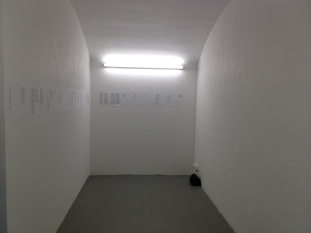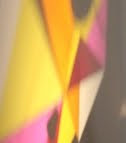rag picking in berlin...
tonight opens my exhibition "rag picking" in berlin at the meinblau kunsthaus, as part of the program of the sunghur. the works include an 8 channel sound work, several drawings, a text work/diary, a small stereo soundwork, and two videos. all of the work evolved from my research of walter benjamin's notebooks here in berlin last october/november.
"the story:
in
october of 2011, carsten seiffarth instigated an invitation by the DAAD
to spend a month researching walter benjamin’s archives at the akademie
der kunste. i had seen some of benjamin’s notebooks previously in an
exhibition in berlin in 2006; and since then, i had become obsessed with
the idea of spending some time with benjamin's archives.
because
i am unable to speak or read german, my responses to benjamin’s
notebooks veered mainly towards the visual aspects of his writing,
including researching various visual systems, organizational decisions,
color coding, as well as more idiosyncratic visual presences. while i
was already, of course, deeply interested in benjamin’s writings, i felt
that i might approach some of the less studied aspects of his writing
(particularly through his visual process of making words visible). much
of my research felt consistent with benjamin's ideas regarding proust
and the idea of the ragpicker - as someone who builds significance
through the use of tossed off or insignificant things.
in
this way, i was able to approach benjamin’s graphic and color-coded
“theme symbols” as a kind of precursor to the graphic notation and
visual systems explored by many avant garde composers of the 1960’s,
such as morton feldman, cornelius cardew and, of course, john cage...
and it was, in fact, cage's use of james joyce's finnegan's wake as
source material for many of his works, that allowed me to follow my own
path through benjamin's notebooks. it was not an academic research, but
more of a conversation - where ideas are doorways to potentials.
benjamin
used a variety of visual systems to organize his notebooks and texts,
using color sequences and graphic symbols to organize his thoughts on
paper. i spent much of my research cataloging various graphic decisions
in an attempt to create scores towards new works. most of my work
engages on some level with ideas and processes of translation; and thus,
the idea was not only to notate benjamin’s lexicon of shapes and
colors, but to explore these findings with an approach of “what can
these things offer me in terms of actions or decision making”. overall
my research was not so much a seeking, as a process of discovery,
archiving, reading, interpreting, and re-reading...
at
the same time, when i arrived in berlin i was already ten months into a
year long project of performing john cage’s 4’33” every day for a year.
thus, each of my daily visits to the benjamin archives were connected
to a daily performance of 4’33”... and so, cage and benjamin became
connected through daily practice and my work. while i performed 4’33” in
many different places in berlin, i performed 4'33" several times in the
benjamin archives.
as
an artist who works in multiple mediums, i found it difficult to remain
within a single medium, and so i have been working with my notations in
sound, video, drawing, writing, etc.
the works:
symbol/cymbal
is an 8 channel sound work, created using 40 "theme symbols" used in
benjamin's notebooks, as a way of connecting fragments in relation to
things such as "prostitution", "crime novels", "reception",
"melancholy", "rebels and spies", etc. i used each symbol to determine
various actions and decisions towards the overall composition of the
work. for instance, an X shape is made by two actions, thus, determining
that the length of time for the X action would be related to #2 of 6
different timings, or that an O shape would be related to a #1 of 6
different timings because drawing a circle is a single action. i also
used the color of each symbol to determine "action streams" so that each
speaker is sounding all of the symbols of a particular color. again,
the idea is to continue to mine the information as deeply as possible,
so that every aspect of a symbol can determine an aspect of the sound -
such as time length, number of sounding actions, dynamics, etc.
in
"a lexicon of silences", i used graphic information discovered in
benjamin’s notebooks, in relation to the various ways in which he
eradicated his mistakes. i noticed that while a large X was his favorite
mode of obliterating mistakes, benjamin had a relatively wide variety
of ways of obliterating his mistakes. thus, i notated and cataloged each
different graphic approach while giving each one a name based on its
shape or form. in this way, a triangle, shaped like a bird’s beak, was
given the name “bird”, while the same shape entirely filled in with
black ink, was named “blackbird”. i then created a that film follows my
hands writing and drawing the entire image/word stream.
i
also created several short stop motion video pieces called ‘cathedral
loops’, which were based on a postcard from a church in sienna that was
part of the remnants of benjamin’s childhood postcard collection.
although this card was published in huge numbers, i was unable to find
the exact same image while searching for over a year's time.
nonetheless, during my search, i found 10 different views from the same
time period, and so i began to think about this idea of multiple views -
as well as minimalist sculpture, based on the cathedral’s columns being
alternating black and white marble lines (like a piano upended).
the
final realizations are a series of drawings, each based on a different
"map" found over 10 pages of benjamin's notebooks. it seems that the use
or meaning of these images - which were drawn over pages of text - are
unclear in terms of meaning or use... thus i transposed the maps onto
paper, and added colors in relation to the order of colored "ticks" in
one of the notebooks - again, using the information as a score towards
the implementation of actions."









1 Comments:
your mention of a system incorporating the number of actions in each of Benjamin's notations reminds me of Japanese dictionaries, where the kanji are organized by stroke count. [Technically, it's by the stroke count of the radical, a recurring/common element of a certain collection of characters, and then by stroke count of the rest of character.]
Post a Comment
<< Home